Antec Eleven Hundred: The P280's Gloves Come Off
by Dustin Sklavos on April 9, 2012 12:00 AM EST- Posted in
- Cases/Cooling/PSUs
- Antec
- mid-tower
Noise and Thermal Testing, Stock
Admittedly with only one comparison point, and that point being about $40 more expensive, the results here are going to be a bit unusual. The Antec Eleven Hundred was clearly designed for performance first and acoustics second, while the Corsair Obsidian 550D's priorities are the other way around. Still, our testbed was refreshed only recently, and we're looking forward to adding more results over time. So while the Obsidian 550D is going to be a potentially interesting comparison point, what we're really looking to ascertain is how much headroom the Eleven Hundred has to work with.
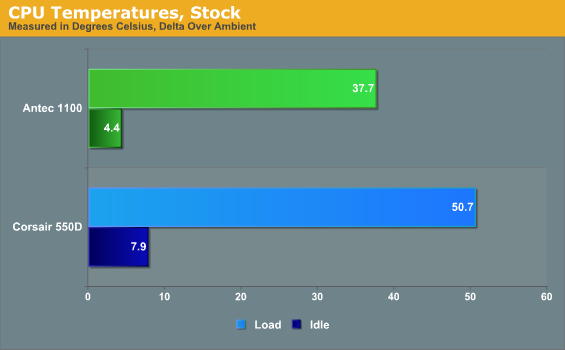
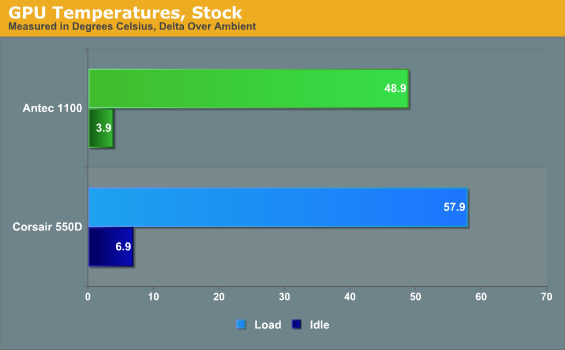
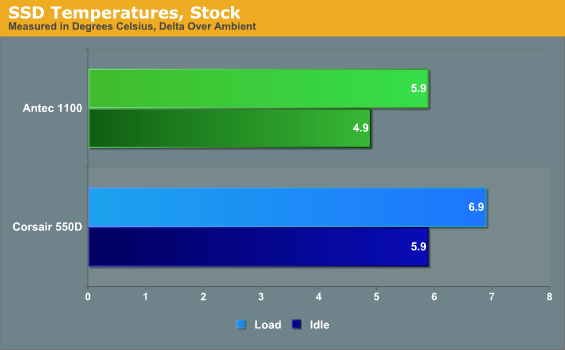
Thermally, the Eleven Hundred puts in a relatively strong showing when taken on its own merits. While we can't strictly compare it to the cases we've previously tested, I can tell you these results are more on the low side. It's taken a while to break my habit of assuming a negative pressure cooling system is inherently "bad," but enclosures like the Eleven Hundred can justify it. With so much ventilation, the Eleven Hundred doesn't have a very hard time getting fresh air in.
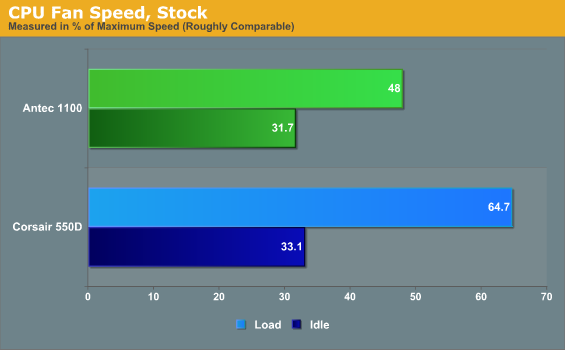
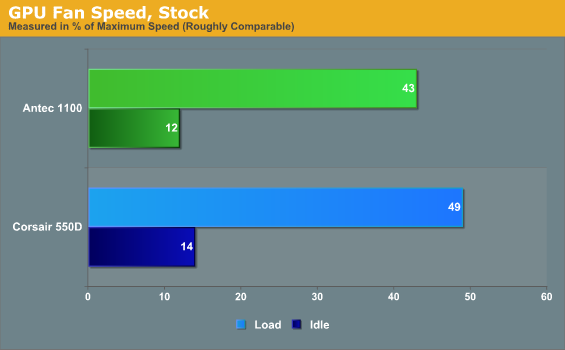
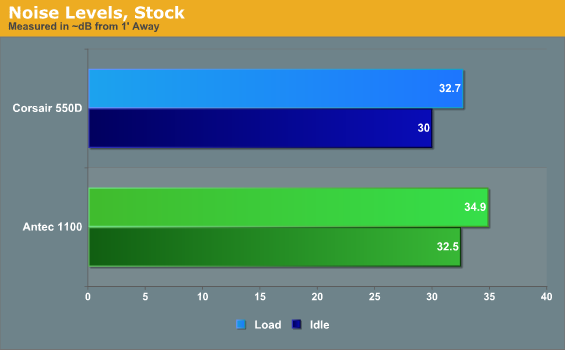
Remarkably the Eleven Hundred isn't particularly loud at stock settings, either, but you'll notice the fans also don't have to work anywhere near as hard as they would in a much more enclosed case like the 550D. This is an important thing to note when you're talking about the balancing act between acoustics and performance; if an enclosure channels air well enough, the fans don't have to work as hard, and thus remain quieter.










40 Comments
View All Comments
jgutz20 - Monday, April 9, 2012 - link
Everyone has the best additions/tests for you to run, yet they arent making their own articles, just criticizing others!Good job on the review, Ohh and you missed a period after that one sentence, please fix it so i can understand what i'm reading
bhima - Monday, April 9, 2012 - link
Would it help to take one of these cases that have been tested in the newer config to be tested in the older test set up as well so we have a baseline difference between the two testing methods? Would that help us get a reasonable idea of how the older cases would perform with the new testing methodologies?Arbie - Monday, April 9, 2012 - link
A big top exhaust is great, but it should have been done as 2x120mm as in the Coolermaster CM690. There is far too little choice of 200mm fans, and then you have to rule out all the sleeve bearing models because it's a horizontal mount. Yes, a single big fan is 'better' than two smaller ones in theory, but the market is far from supporting that approach.cyberguyz - Monday, April 9, 2012 - link
I absolutely hate reviews like this. Anand, fire this guy!Why do jokers like this guy review fill size cases with mATX motherboards? If you review an mATX case, then fine, use an mATX motherboard.
Guys, these are full size cases, designed to hold full sized ATX motherboards. Any jackass can assemble a 'clean' and uncluttered system using any case like this size and an mATX motherboard. Try it using real full ATX motherboards and then tell us how much room you have in there to assemble your rig.
Don't slap in an mATX board, then say "Oh lookie how roomy this case is!!". To do anything else is to do a half-assed case review that is not worth the few minutes of wasted life it takes to read it.
At least he didn't attempt to pass off uber this case is by mounting a mini ITX board in it.
JarredWalton - Monday, April 9, 2012 - link
Reading comprehension fail, I suppose? We linked our testing methodology article, but the simple reason for using mATX is that mATX can support just as much performance as most ATX. Now we can compare ATX and mATX cases against each other, rather than having to use two different motherboards. And amazingly enough, you CAN tell how spacious a case is without installing a large motherboard -- though I don't seem to recall "roominess" being mentioned as a selling point here.Twoboxer - Monday, April 9, 2012 - link
Reviewers need to pay more attention to comparisons between negative- and positive-pressure cases. The major benefit to a positive-pressure case does NOT show up in even the most thorough (short-term) review.A negative-pressure case draws air in from every crack and crevice. These openings cannot be filtered and so inevitably your optical drives, card readers, usb ports, fan blade edges, and cooling coils become clogged with dust.
In a positive-pressure case, each of the intakes can easily be filtered leaving the interior dust free.
I'm not aware of any compelling thermodynamic advantage to a negative-pressure case, either theoretical or practical. There are at least some anecdotal reasons to believe-positive pressure cases have a theoretical advantage in sound dampening.
If that's correct, Reviewers should be helping us all get more positive-pressure case designs by factoring this consideration into their reviews of price/performance. OTOH, if negative-pressure cases do have a thermodynamic advantage, it would be interesting to quantify it in some way.
Because AFAIC, even if a positive-pressure case ran a couple of degrees warmer and cost a few dollars more, that case is by far preferable to a negative-pressure case for almost all users.
quanta - Tuesday, April 10, 2012 - link
Am I the only one who noticed many of the so-called high-end case have been steadily losing external drive bays? There used to be 6 to 7 bays even on medium cases, but lately you'll be lucky to find 4 bays. With the use of optical drive, memory card reader and fan controller, the spare front panels are pretty much gone. The side-loading drive bays are arguably less versatile than front-loading variety, because there are no aftermarket hot swap bay fitting 3.5-inch drive bays. However, front hot swap bay requires no manual disconnection of cables or removing front panel once it is installed, saving time for hardware testing. Besides, the 5.25-in external bays are perfect for cooling bay for hard drives, and handy for converting them into intake fan slots.ShieTar - Tuesday, April 10, 2012 - link
There is always the Lian Li PC-V343B if you just can not get enough external bays. 18x5.25" should seriously be enough for everybody. But testing it with an mATX board an no watercooling by be somewhat insulting to the case.But in general you are correct. If you go on any price-comparison site, you should still find that about 10% of all cases have at least six 5.25" bays, but on closer inspection you will see that most of those are somewhat older designs.
I assume the main reason for this is the fact that more and more people get sepparate storage systems and use their main systems with one (or two) SSDs as Game/Work Systems only. And Anandtech, as much as I personally enjoy their tests, are really just picking a small sample of all cases available with their 20 or so tests per year, so it is understandable if they concentrate on the one or two cases per manufacturer which can be expected to be of interest for the majority of customers/readers.
olafgarten - Saturday, November 30, 2013 - link
the case actually supports an XL-ATXSeanJ76 - Thursday, January 28, 2016 - link
Antec Eleven hundred v2 is one of the best cases you can own.....